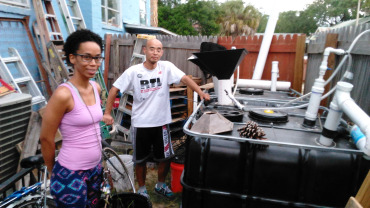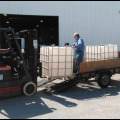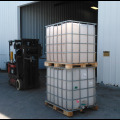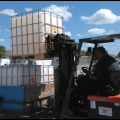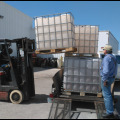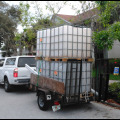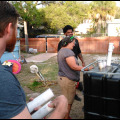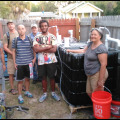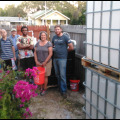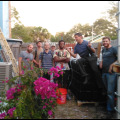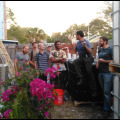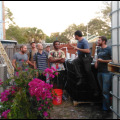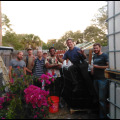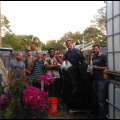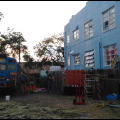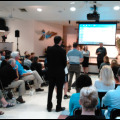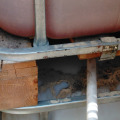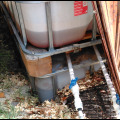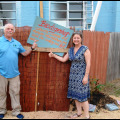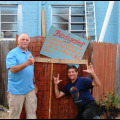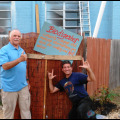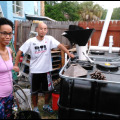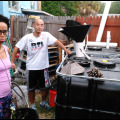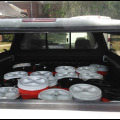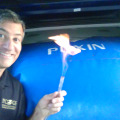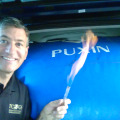
The system at the St. Petersburg Eco-village was built on a USF Interdisciplinary Grant awarded to Dr. David Randle for collaborative research in the UN Observatories areas he established. This is a project being conducted with USF and Patel College Dean Richard Berman and Dr. Louis Zunguze with the team of Ecovillage Permaculture Leader Cristy Abbot and founder Chris Kenrick.
The four IBC tanks used in the system were donated by Alessi Foods/Vigo Importing of Tampa Florida through efforts made by Dr. Culhane and Dr. Eric Weaver. They were transported to St. Petersburg by community partner and biodigester education volunteer Ken Black a.k.a. "Moringaman". The system was built by Dr. Culhane and students from the Patel College of Global Sustainability (USF Tampa) Food Energy Water Nexus Class with volunteer residents from the St. Pete Eco-village.
[[{"fid":"1891","view_mode":"content_medium","fields":{"format":"content_medium","field_file_image_alt_text[und][0][value]":"St. Petersburg Ecovillage Digester Gas Holder System with Sump Pump","field_file_image_title_text[und][0][value]":"St. Petersburg Ecovillage Digester Gas Holder System with Sump Pump"},"type":"media","field_deltas":{"1":{"format":"content_medium","field_file_image_alt_text[und][0][value]":"St. Petersburg Ecovillage Digester Gas Holder System with Sump Pump","field_file_image_title_text[und][0][value]":"St. Petersburg Ecovillage Digester Gas Holder System with Sump Pump"}},"attributes":{"alt":"St. Petersburg Ecovillage Digester Gas Holder System with Sump Pump","title":"St. Petersburg Ecovillage Digester Gas Holder System with Sump Pump","class":"media-element file-content-medium","data-delta":"1"}}]]
This system follows a design that Culhane and Solar CITIES colleagues Hanna Fathy and Mike Rimoin first experimented with in Cairo Egypt in 2009 that was subsequently tested in Los Angeles, Sonoma County, Alaska, Sao Paolo, Brazil and Tamera Portugal as well as Rosebud Continuum in Land O' Lakes Florida and the Sustainable Living Center in Tampa. The system in the "Favela de Paz" apartment building in Sao Paulo, built by Paulo Mellett, Ruth Andrade and Fabio Poesia Sambasoul (see http://solarcities.eu/projects/3-ibc-water-displacement-system) is the longest running system of this kind, since January of 2014, where it provides gas for several families reliably. ( See also the video at https://www.youtube.com/watch?v=1W6V3QGs9fA).
Since we have had success with this system around the world before, it was felt that this would be the best system to create for the Ecovillage. The one we created in St. Petersburg uses two Solar CITIES IBC tanks as its digesters (the twin dragons) and uses two IBC tanks, stacked, as its water displacement storage and pressurization system.
The system at St. Pete Ecovillage, as well as the systems the same group of students built with Culhane at the Sustainable Living Center across from Lowry Park Zoo and at the Rosebud Continuum, where Culhane lives, are different from the systems in Brazil, Portugal, Alaska and California in that for the first time we were able to locate the gas storage tanks for these digesters UNDER GROUND and keep the water displacement tank above them at ground level.
Locating the gas storage tank underground minimizes the visual impact of and space needed for the system in a limited urban setting. It also helps address any concerns people who are unfamiliar with the safety of biogas may have. In this system the tank below ground starts out filled with water. That water is displaced to the tank above it by gas pressure that causes it to overspill into a sump from whence a sump pump carries it to the empty tank above. In this way, as gas begins to fill the buried tank, an equivalent amount of water begins to fill the above tank. The amount of gas stored can easily be ascertained, viewed and measured by simply observing the amount of water contained in the upper tank. Observers never see the gas which is safely contained under the water displacement tank. To allay fears (which are unfounded anyway) we have demonstrated to fire marshalls that IF somebody tried to sabotage the system by forcing air in the underground gas tank and trying to light it (very hard to do), any flame or rupture in the plastic tank would cause the water above to spill down and extinguish it. In this sense the system is self-extinguishing.
The advantage of this system is that the displaced water, which flows back down into the gas storage tank when the gas is used in the kitchen, is under enough gravity to give a good pressure when used with stoves, gas lamps or generators.
The disadvantage of this IBC water displacement and pressurization system is that it requires a sump and a sump pump and extra tubing, which adds to the cost, and it requires electricity. This is not a problem for the ecovillage, to whom Dr. Randle supplied the materials along with an outdoor extension cable. The electricity required is mimimal and sump pumps are easy to obtain. But in remote areas or areas with no reliable electricity and no funds for the necessary solar or other renewable energy systems and storage, this design is not optimal. For such areas we instead recommend the Solar CITIES Floating IBC gas storage system. In this one the twin dragons are identical (i.e. the digesters are the same) but rather than use a tank on top of a tank for water displacement gas storage, we cut up two IBC tanks and rotate them and bend their cages out so that one tank fits inside another and floats up and down inside a bath of water, similar to the Indian "floating drum" digester design, but made from IBCs. In such a system no electricity is necessary and this has advantages.
For example, for Dr. Randle's USF Interdisciplinary Grant project in Cuba, we decided to bring tanks donated to the project by Solar CITIES and the Rosebud Continuum and drive them to Key West to put on a sailboat to take to Havana's Hemingway Marina. If we had tried to bring 4 intact tanks to replicate the Water Displacement gas storage and pressurization system, we would have needed a much larger truck and boat. With the floating IBC system from Solar CITIES one tank can be slid into another and the footpring for transport is lower. Additionally, the floating IBC, rising by itself in the tank of water as it fills with gas, requires no sump pump and hence no electricity.
The disadvantage of the floating IBC gas storage method is that the floating gas tank doesn't provide a lot of pressure. With time and experimentation as we use it in certain locations, we figure out how much pressure is needed for whatever stove is being used and the distance to the point of use and compensate by placing a board with some weights on it to get to the desired pressure, as the Indians do with their plastic ARTI floating tank systems.
Another disadvantage is that the cages of the floating IBC tanks must have most of their metal ribs cut out and then have the cage stretched or bowed out to make it easy for the gas holder to slide up and down. When we built tanks in Palestine that did not have sufficient bowing, the gas holder tended to get stuck, discouraging people from using them. To fix this problem, Culhane and USF studentsand HCC students had earlier built identical systems to the one being brought to Cuba at MOSI (the Museum of Science and Industry), at Hillborough Community College, at the USF Hillel, at the Koreen Brennan Permaculture Farm in Brooksville FL, at ECHO Village in Fort Meyers and at Rosebud Continuum to ensure good operation and quality control. USF FEW NEXUS students Jerry Commelas and Li Zhu and Culhane and students at MOSI along with the permaculturalists in Brooksville created and mastered several techniques for ensuring good movement of the gas holder and it was considered finally to be more reliable than the stacked tank water displacement system used here at the Ecovillage, particularly because it requires no additional materials once the cages are cut and bent (it should be said though that an advantage of the water displacement system is that the tanks don't need to be altered or damaged at all, so that if one wanted to one could use the tanks for other purposes, including water storage, wheras when the tanks are cut for the floating IBC system they are dedicated thereafter to their job as a gas floating gas holder system.)
There are obviously benefits and costs and advantages and disadvanatages and pros and cons to any given design.
It is our belief that for situations like Cuba where the materials had to be transported long distances, where extra cost is a big concern and where materials are scarce, electricity is non existent or hard to come by or guarantee, and regular maintanence might be difficult, the floating IBC gas storage system is best suited, since it is passive, even though it requires more upfront labor and doesn't provide optimum pressure. Meanwhile, where one can afford a sump pump, where electricity and the infrastructure for it is easily had, where budget permits and higher pressure gas is desired, and where designers may want to repurpose the tanks, the water displacement system may be better.
With all the sites we now have built of the two designs in the South Florida area, uture research by end users in the field will help each new project make the best decision as to which design for gas storage and pressurization to go with. The digesters themselves remain the same Solar CITIES IBC design as ever.

